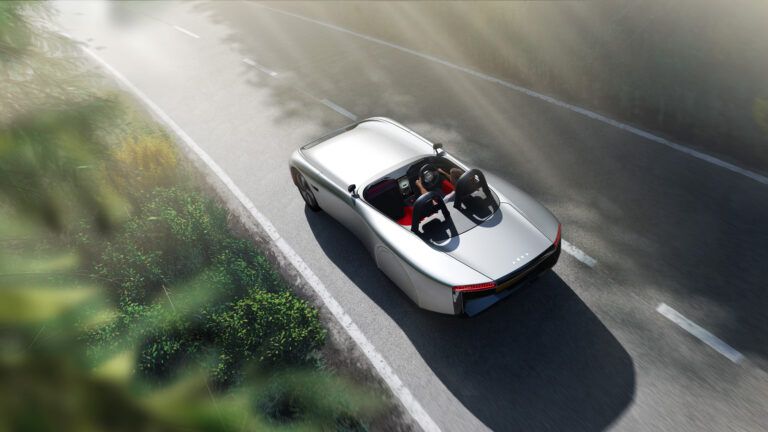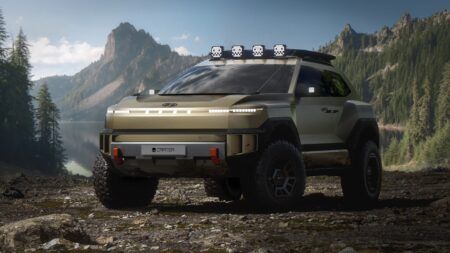An all-electric British sports car concept has been revealed that aims to show what the future of motoring could look like, with a design that is inspired by nature and performance that offers over 400 miles of range.
The Aura concept car, unveiled at the CENEX-LCV show at Millbrook Proving Ground, is a two-seater roofless sports car utilizes natural fiber composites and efficient electric power to deliver a long-range electric vehicle (EV) with sustainability at its core.
Funded by the Office for Zero Emission Vehicles (OZEV) through the Niche Vehicle Network (NVN), the Aura concept car has been designed, developed and hand built by four innovative British suppliers. They started together in October 2020 to create a low emission sports car that is efficient on power and its demands on the world around it, through its engineering, design and technology inputs. The concept came from the understanding that as the automotive industry evolves, and the transportation needs of individuals changes, there will be a demand for a product that encompasses these requirements.

Aura aims to reduce environmental impact through low-drag design, lightweight natural composites, innovative driver feedback and an 88kWh multi-pack battery architecture delivering a range of around 400miles.
All four UK-based companies responsible for the Aura concept car specialize in efficiencies of light weight, low drag and innovative uses of technology to solve consumer issues with running an EV. From placing the batteries and motors in optimized positions to providing rear cowling to the wheels to reduce the strain on the sportscar as it glides through the air, the team has also incorporated natural composite fibers for the bodywork that are not only lightweight but more sustainable within the manufacturing process. Aiming to show that EV adoption is more accessible than users think, its cutting-edge HMI not only aims to reduce driver distraction through its driver infotainment (which includes a self-levelling driver display in the center of the steering wheel) as well as reducing range anxiety through real-world map and charging availability.
The British companies behind Aura include, Astheimer Design, a design studio focused on delivering mobility solutions for a sustainable future. Its vision was a pure, simple, iconic low-drag, efficient design that has been analyzed at length using Computational Fluid Dynamics (CFD) testing. Maximizing efficiency and the long-range of the Potenza Technology electric batteries and motors, Astheimer’s team added rear wheel covers and air curtains and large rear diffuser to reduce the vehicle’s overall wake, thus needing to use less energy and increasing Aura’s real-world range.
Using natural composite fibers from BAMD Composites and BCOMP natural woven fabric, the material specialist has added a lightweight but viable production option to manufacture the body panels, which again means that there’s less mass for the 44kWh (88kWh total) Potenza Technology batteries to power and drive the Aura sports car. BAMD’s use of natural fibers is also cleaner on the environment to produce and recycle compared to metal equivalents and has also been matched with sustainable vegan leather in the interior.
Aura is powered by a rear-wheel drive all-electric powertrain and is capable of a range of around 400 miles through two 44 kWh batteries (total 88 kWh). Thanks to innovative packaging, situating the motor at the front, and the other underneath the car’s chassis. Studied at length, the situation of the cells also improves driver dynamics and engagement for the driver due to the neutral weight distribution, with the engine bay pack located at the front of Aura and an undertray pack bolted to the chassis. It also means that the packs can easily be accessed for maintenance in the future. Potenza Technology’s powertrain team has fitted Aura with large diameter low rolling resistance wheels and tires utilizes its fifth generation of the Potenza Battery Management System, too.
Aiming to keep the focus on driving and the road ahead, Conjure has incorporated a five-inch, self-levelling, circular steering wheel-mounted display that has the key information such as range, weather and other relevant driving information. Working together with the ten-inch touchscreen in the middle of the cabin, both screens will be run by one single computing unit. Conjure has provided a virtual 3D view real-world performance and aerodynamic views that also updates the driver and allows them to update their driving styles to maximize their range based on their surroundings.
Alex Stewart, Senior Design Engineer at Astheimer Design said: “The challenge of any design engineer is to translate the initial design intent into reality, and this needs to be done respecting all the constraints, including time and cost, alongside the technical, functional and legislative aspects. This means starting with a comprehensive feasibility study, investigating the technologies, materials, and processes to be able to create a one-off road legal concept car.
The development of the car with these challenging constraints required disciplined project management and a close cross partner collaboration between the 4 partners. Working with Potenza to define the vehicle package and light weight chassis, with BAMD to determine the panel properties and detailing, and with Conjure for the electrical integration of the HMI systems. We then started by defining the build strategy, rationalizing the part break down and creating a full bill of materials (BOM) for the car.
Being road legal meant that structural integrity was of utmost importance whilst ensuring a fit and finish of the highest quality. This was achieved with molded substructures that created a “jig” for the majority of the body panels.
Being a one-off concept car meant that we have used a combination of different materials, processes and technologies for the manufacture of parts. The main body panels are made using natural fiber composites and we have 3D printed many of the details, we used our in house prototyping hardware as much as we could and the fitting, finishing and assembly of the exterior and interior bodywork were all done in our workshop below our design studio.”





